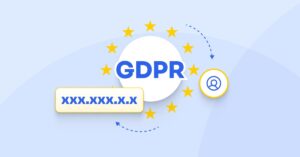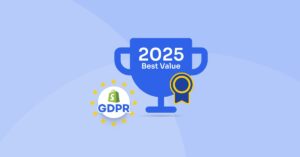Introduction
Data has become a crucial resource for businesses. It serves as the foundation for decision-making and facilitates growth. With the introduction of Google Analytics 4 (GA4), data collection and analysis have been taken to a whole new level, providing businesses with unparalleled insights into user behavior and website performance. However, with great power comes great responsibility. In this data-driven era, businesses must also prioritize data privacy, especially in light of laws such as the General Data Protection Regulation (GDPR) and other regulations that may arise in the future.
GDPR compliance: A legal imperative
The General Data Protection Regulation (GDPR) is a set of rules and regulations implemented by the European Union (EU) to safeguard the collection and processing of personal data. It stresses the importance of obtaining explicit user consent for data transfers, ensuring the safety of personal data, and providing individuals with the right to delete their data. For GA4 users, it is crucial to have a comprehensive understanding of these guidelines to ensure compliance and avoid any potential legal issues.
The role of Google Analytics 4
Google Analytics 4 (GA4) is the latest version of Google’s popular web analytics tool. It has been designed with data privacy in mind and comes equipped with a range of features and data settings, that can assist businesses in their GDPR compliance journey. GA4 has evolved significantly since its introduction and now offers improved capabilities and addresses new challenges. Its user-friendly interface and robust reporting capabilities make it an essential tool for businesses looking to improve their online presence and drive growth. With GA4, businesses can gain valuable insights into their website traffic, user behavior, and marketing campaigns, allowing them to make data-driven decisions and optimize their online performance.
Transition from Universal Analytics (UA)
With the introduction of GA4, Google has brought forth a new wave of analytics for businesses to take advantage of. Many companies are choosing to transition from Universal Analytics to GA4 to access the improved tracking and reporting functionalities offered by this next-generation analytics tool.
Advanced segmentation
With the advanced segmentation features introduced by GA4, businesses can gain deeper insights into their audience by segmenting them based on various parameters. This not only helps in understanding their audience better but also in tailoring marketing efforts effectively to drive better results. Businesses can identify patterns, trends, and opportunities by analyzing data from different segments and making data-driven decisions to optimize their marketing strategy. Overall, the advanced segmentation features of GA4 provide businesses with a powerful tool to improve their marketing efforts and drive growth.
Tips and tricks
As more and more businesses adopt GA4, there is a growing need to fully understand its capabilities. Fortunately, there are numerous tips and tricks available to help users maximize its potential. Businesses can gain a competitive edge and achieve more tremendous success by harnessing its power for better data analysis and decision-making.

Comparison with Universal Analytics
A detailed analysis was conducted to compare the features of GA4 and Universal Analytics. The findings highlighted the advantages and disadvantages of each platform. It was observed that GA4 has taken into account the limitations of its predecessor and has introduced improved tracking options for user interactions.
Ultimate guide to Google Analytics
Google Analytics is a powerful tool that provides valuable insights into website traffic and user behavior. To make the most of this tool, comprehensive guides have been published to help users navigate it effectively. These guides cover various aspects, including data collection, reporting, and optimization of analytics data.
Setup guides
To expand on the previous instructions, it’s important to ensure that all the necessary data is being tracked in GA4. This includes events such as button clicks, form submissions, and video views. To do this, website owners can use the GA4 event builder tool to create custom events that match their specific needs. Additionally, it’s important to set up conversion tracking to measure the success of specific actions on the website, such as purchases or form submissions. By properly setting up GA4 for their website, owners can gain valuable insights into user behavior and make data-driven decisions to improve their online presence.
Pros and cons
Businesses have extensively weighed the benefits and drawbacks of GA4. On one hand, it offers advanced features that provide better tracking and insights. On the other hand, some challenges have been noted, such as adjusting to the new interface. Despite these hurdles, GA4 has undergone substantial development and adoption in the marketing and analytics landscape up to 2023. Its advanced features, guides, and comparisons have helped businesses make the most of this analytics platform, leading to increased efficiency and success in their digital marketing strategies.
Key considerations for GDPR and GA4 compliance
1. Data retention settings
With GA4, you have the ability to tailor data retention periods to your specific needs. This means you can determine how long user data is kept within your analytics account. This feature is particularly useful for businesses looking to comply with GDPR regulations, as it ensures that data is not stored for longer than necessary. By customizing data retention periods, you can maintain a more efficient and secure analytics account while also protecting user privacy.
2. IP anonymization
In Google Analytics 4, there is a notable update regarding IP anonymization. This feature is now set as default, which means that complete IP addresses are not stored in GA4 by default. This is a significant enhancement for user privacy and is also important for GDPR compliance. By anonymizing IP addresses, the risk of collecting personally identifiable information is greatly reduced.
3. Consent mode
Google Consent Mode is a valuable feature for businesses looking to comply with GDPR regulations. By implementing this tool, websites can more effectively determine when to ask for user consent before collecting data, granting greater control over data processing. This can help to ensure that user privacy is protected and that businesses remain in compliance with important regulations.
4. Data deletion requests
The General Data Protection Regulation (GDPR) includes a fundamental right for individuals to have their personal data deleted. This means that as a GA4 user, you must be ready to respond quickly and appropriately to any requests for data deletion from your users. Implementing efficient procedures is crucial to meet this requirement of the regulation.
5. Cookies and explicit consent
The General Data Protection Regulation (GDPR) has brought about changes in the way websites handle user data. One such change is the treatment of cookies used by Google Analytics. These cookies may be considered personal data, and as such, websites must obtain explicit consent from users before collecting such information. This adds another layer of complexity to data privacy compliance, making it imperative for businesses to take a proactive approach to ensure compliance with GDPR.

Practical steps towards compliance
Achieving GDPR compliance in the GA4 era requires a strategic approach:
1. Education and training
Providing comprehensive training is one important aspect of ensuring that your team understands the intricacies of GDPR and how it relates to GA4. By doing so, your staff can learn how to effectively navigate the complexities of data privacy regulations and ensure compliance. This will not only protect your business from potential legal or financial repercussions but also build trust with your customers by demonstrating a commitment to protecting their sensitive information.
2. Data minimization
When collecting data for analytics purposes, it’s crucial to ensure that you are only collecting the necessary information. You should avoid collecting excess data and regularly review and update your data collection practices to comply with GDPR. By doing so, you can ensure that you are protecting the privacy of your users and maintaining their trust in your organization.
3. Consent management platforms
Consent management platforms are increasingly becoming popular as they offer a convenient way to obtain user consent. These platforms enable users to have a say in how their data is collected and processed. Consent management platforms ensure that users can make informed choices by providing users with the necessary information about data collection and processing. Additionally, these platforms can help organizations comply with data protection regulations. Overall, implementing a consent management platform can be an effective way to streamline the process of obtaining user consent while ensuring user privacy is respected.
4. Continuous monitoring
As data privacy laws continue to evolve, it’s important to stay up-to-date with any changes and ensure that your data handling practices and policies are always in compliance. Regularly reviewing and updating these practices can help protect the privacy and security of your user’s information.

The future of data privacy
Data privacy concerns will persist as technology and data analytics continue to advance. Here are some trends to watch for:
1. Stricter regulations
In the coming years, we can expect to see a significant increase in the stringency of data protection laws around the world. Governments and regulatory bodies are placing a greater emphasis on user consent and data protection, which will have far-reaching impacts on businesses of all sizes and in all industries. Companies must proactively comply with data protection authorities to safeguard customer information privacy and security.
2. Enhanced data minimization
As the importance of data privacy and security continues to grow, businesses are taking a more cautious approach when it comes to collecting and storing data. To mitigate risks and ensure compliance with regulations like GDPR, companies are focusing on collecting only the essential data they need to operate effectively. This approach not only reduces the burden of compliance but also minimizes the potential risks associated with handling sensitive data. By taking a more targeted approach to data collection, businesses can better protect their customers’ information and safeguard their own reputation.
3. Evolving analytics
As data privacy requirements continue to evolve, analytics platforms such as GA4 are constantly adapting to meet these changes. These platforms not only provide deeper insights into user behavior but also prioritize the protection of personal data. With these safeguards in place, users can trust that their information is secure while still benefiting from the valuable insights these platforms provide.
Conclusion
In the GA4 era, data privacy isn’t merely a legal requirement; it’s a competitive advantage and a testament to your commitment to user trust. Navigating data privacy in this environment requires a comprehensive understanding of GDPR, diligent use of GA4 features, and a proactive approach to compliance. By embracing responsible data handling and staying vigilant, businesses can leverage the power of GA4 while safeguarding user data and maintaining GDPR compliance. Remember, data privacy is an ongoing journey, and staying ahead of the curve will ensure your business thrives in this data-driven age.







